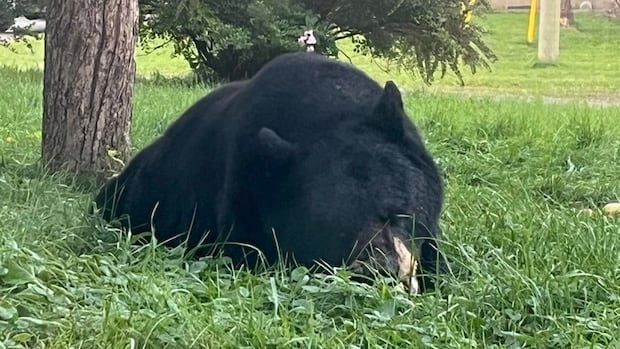When Thunder Bay resident Jeff Tiboni walked around the corner of his house one evening, he found a black bear lying under a tree in his neighbour’s yard.
“We went to do some work in front of the house and walked around the corner, and it was just lying there under the tree, eating apples. Just looked up at me. I backed off a little bit and left it alone,” Tiboni said.
“I did set off a bear banger to try and discourage him from coming around. All he did was go around the edge of the house that was next door. Started looking in the trees again and was right back into the apple trees within like five minutes.”
He lives near a large park and said seeing bears is not unusual, but this year has been different.
“Typically, during the fall and regular bear season years, we do have them. Maybe later in October, we’ll see them for a couple of days here and there, but this year seems to be a lot more than usual,” he said.
Tiboni said once the apples were eaten, bears started moving on to garbage cans.
“The food source obviously attracts them. The apples are a big source for them. I personally don’t have an apple tree. The neighbour has one and that’s kind of what draws them in,” he said.
The Ontario Ministry of Natural Resources (MNR) states that bears are in hyperphagia, a stage preceding hibernation, when they spend up to 20 hours a day eating. They can consume as many as 20,000 calories daily.
“Bears are seeking food sources to fatten up for hibernation. And so apple trees are especially appealing to bears during the late summer and fall when the fruit becomes ripe,” said Micheline Mamone, provincial coordinator for human-wildlife Management at the MNR.
She says fluctuations in natural food sources in a bear’s habitat, such as berries, acorns and nuts, often explain spikes in bear sightings. A poor berry crop this year has forced many bears to seek food in residential areas.
“There are often food sources in urban and residential areas like food waste, garbage, bird feeders, compost, pet food and fruit trees that the bears may come and take advantage of,” said Mamone.
7:16Cluster of bear encounters in Thunder Bay
Thunder Bay residents are reporting plenty of bear sightings in recent weeks. We heard from resident Fred Fingler and Micheline Mamone, provincial coordinator of human wildlife interactions with the Ministry of Natural Resources.
Tips for reducing bear attractants
-
Fruit trees: Pick apples, pears or plums as soon as they ripen, and clean up fallen fruit quickly.
-
Garbage: Store it in a secure garage or bear-resistant container. Clean bins regularly to remove grease and food residue.
-
Bird feeders: Only put them out in winter, between December and April, when bears are hibernating.
-
Pet food: Feed cats and dogs indoors, never outside.
-
Barbecues: Burn off grease after cooking and empty grease traps.
Mamone said these small steps make a big difference: “We don’t have anything on our property that might attract a bear because if they can’t find any food, they will simply move on and try and find it elsewhere.”
The City of Thunder Bay says residents can dispose of apples and other yard waste during two fall collection periods, which include October 7-17 and November 4-14 on regular recycling days.
What to do if you see a bear
Mamone says non-emergency encounters, such as a bear eating apples in a yard, should be reported to the province’s Bear Wise reporting line at 1-866-514-2327. Emergency encounters, including a bear trying to enter a building, lingering after killing a pet or livestock, or appearing in a school zone, should be reported to local police or 911.
“It really is a community effort, especially in residential areas. Neighbours working together to make sure that everybody is managing their property in a way that won’t attract bears to the neighbourhood,” said Mamone.







